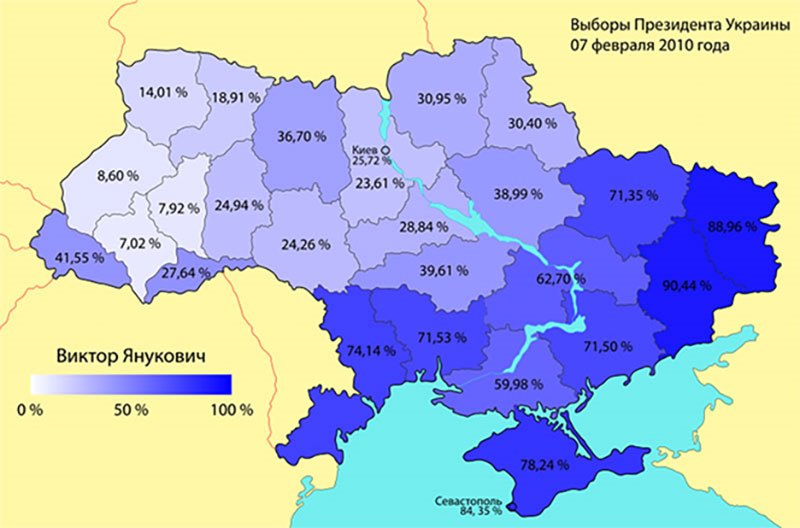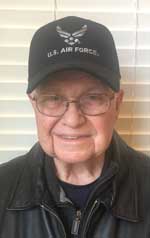An Election Map Tells It All
Ukraine Presidential Election Map 2010. Percent for Viktor Yanukovych

Sixty to ninety percent of the voters in Crimea and 8 other southern and eastern oblasts voted for Yanukovych: Donetsk 90%, Lugansk 89%, Crimea 78%, Odessa 74%, Zaporizhia 72%, Mykolaiv 72%, Kharkiv 71%, Dnepropetrovsk 63%, and Kherson 60%. These correspond to Russian primary language percentages of 50 to 90 percent. \
This map shows pretty clearly where Russian language and culture predominate, which is a major factor underlying the Civil War beginning in 2014 and the current conflict between the Ukrainian government and the Russian Federation. A major issue since 2014 and the U.S. backed Maidan coup, which forced Yanukovych out of office, has been Ukrainian government discrimination against Russian ethnicity and ethnic cleansing of Russian language, religion, and culture. Since close to 5,000 Russian ethnic civilians in the Donbass region (Donetsk and Lugansk oblasts) have been killed largely by Ukrainian artillery shelling of civilian areas, some have termed this ethnic genocide.
Only 60 percent of Ukrainians consider Ukrainian their native language. Close to 18 percent consider Russian their native language. About 22 consider both Russian and Ukrainian to be their native language.
Crimea became part of the Russian Empire in 1783. Crimea is currently only 15% Ukrainian and has never been more than 25% Ukrainian. Sevastopol, Crimea’s largest city has been a major strategic Russian naval base on the Black Sea since 1783. It was leased by treaty from Ukraine from 1991 to 2014. Predominantly Russian in ethnic background, language, and culture, over 84% of Sevastopol voted for Yanukovych in 2010.
Crimea was part of Russian SSR of the Soviet Union until February 19, 1954, when it was by administrative action transferred to the Ukrainian SSR of the Soviet Union. First Secretary of the Soviet Communist Party Nikita Khrushchev, former First Secretary of the Ukrainian Communist Party, rammed the action through the Presidium of the Supreme Soviet with only 13 of 27 members present. There was no referendum and the action was controversial in the Soviet system. Khruschev’s motive, along with some tendencies to Ukrainian favoritism, was allegedly to secure the support of then First Secretary of the Ukrainian Communist Party, Oleksiy Kyrychenko, to strengthen Khrushchev’s then precarious political position against Soviet Prime Minister Georgy Malenkov. The action would also increase the Russian population of Ukraine. The action was fraught with controversy but did not become a military and naval controversy until the breakup of the Soviet Union in 1991. It was never popular in Crimea or Russia.
On March 14, 2014, following the unlawful Maidan coup against Ukrainian President Yanukovych, the Supreme Council of Crimea and the Sevastopol City Council adopted a declaration of independence from Ukraine with intent to rejoin the Russian Federation. This was approved by 97% of voters in a referendum March 16. Voter turnout was 89% in Sevastopol and 83% in the rest of Crimea. Many independent polls confirmed overwhelming support for Russian annexation, which the Russian Federation formally approved as an Accession of Crimea into the Russian Federation on March 18. The Crimean Referendum and subsequent Accessation of Crimea into the Russian Federation, according to Russian President Vladimir Putin, were consistent with the principles of the self-determination of peoples in international law. In fact, self-determination was a principle underlying the American Revolutionary War and was promoted by the League of Nations after World War I and continues as a principle of the United Nations. .
There was no real battle for Crimea in 2014. Ukrainian opposition collapsed because its forces were largely Russian ethnics, who quickly went over to the Russian side. There were only three military and two civilian deaths. Bringing back Ukrainian rule to Crimea seems an incredibly foolish errand likely to explode into more and greater dangers and sorrows—World War III.
The isolated rather high 42% vote for Yanukovych in the Carpathian Mountains of western Ukraine is Zakarpattia oblast (Transcarpathia), with a 12%, or 150,000, Hungarian minority near the Hungarian border. The Ukrainians mistreat the Hungarian minority, just as they do the much larger Russian minority across Ukraine. The Hungarian minority feels Ukraine is trying to erase their cultural, linguistic, and ethnic identity. This has bred aversion to the war, and there have been problems over drafting underage Hungarian boys, whose families believe are being made cannon-fodder for questionable or convoluted objectives, which they find difficult to embrace. No one wants to sacrifice their children to empty bromides, dubious morality, or madness.
“Whom the Gods would destroy, they first make mad.”









 Mike Scruggs is the author of two books: The Un-Civil War: Shattering the Historical Myths; and Lessons from the Vietnam War: Truths the Media Never Told You, and over 600 articles on military history, national security, intelligent design, genealogical genetics, immigration, current political affairs, Islam, and the Middle East.
Mike Scruggs is the author of two books: The Un-Civil War: Shattering the Historical Myths; and Lessons from the Vietnam War: Truths the Media Never Told You, and over 600 articles on military history, national security, intelligent design, genealogical genetics, immigration, current political affairs, Islam, and the Middle East. 


